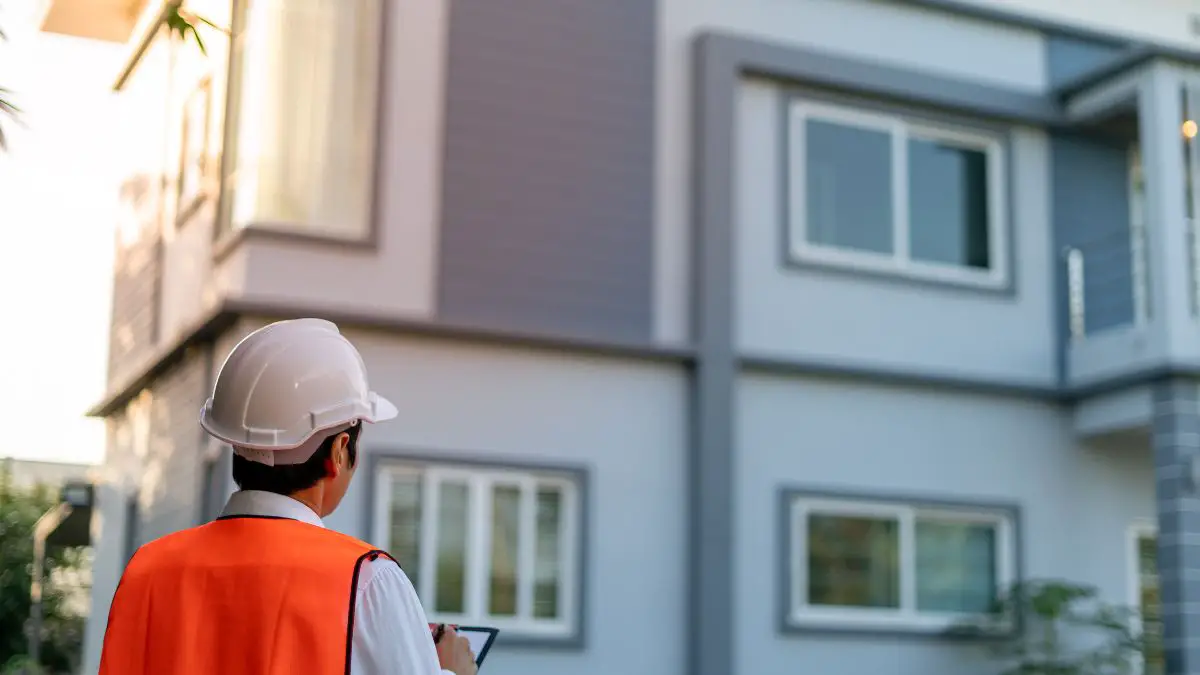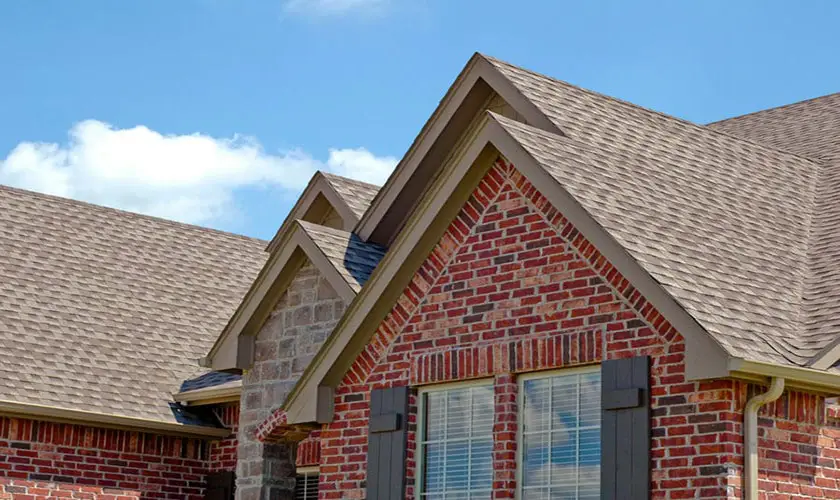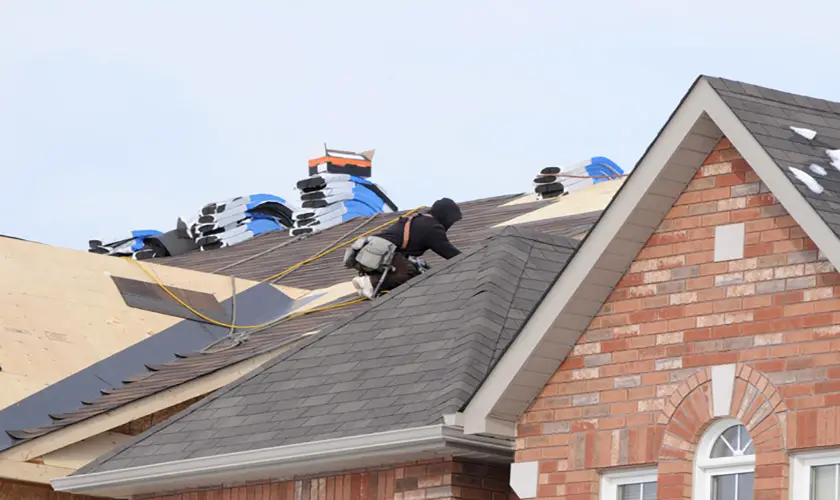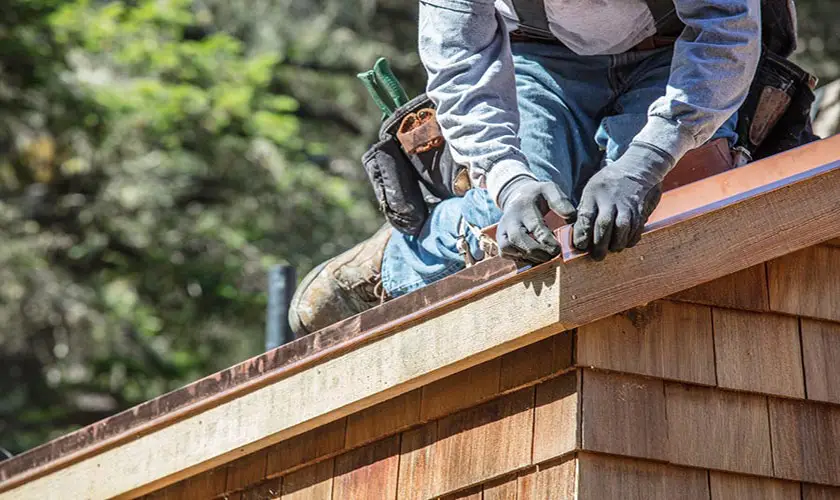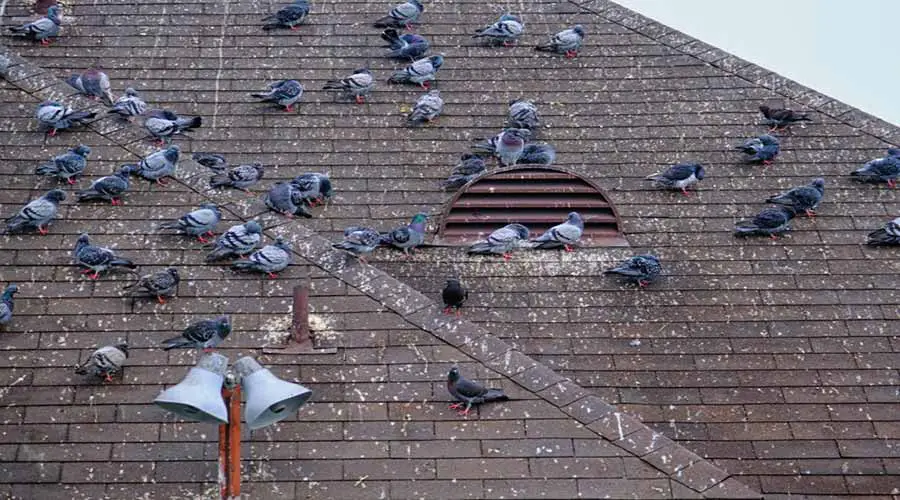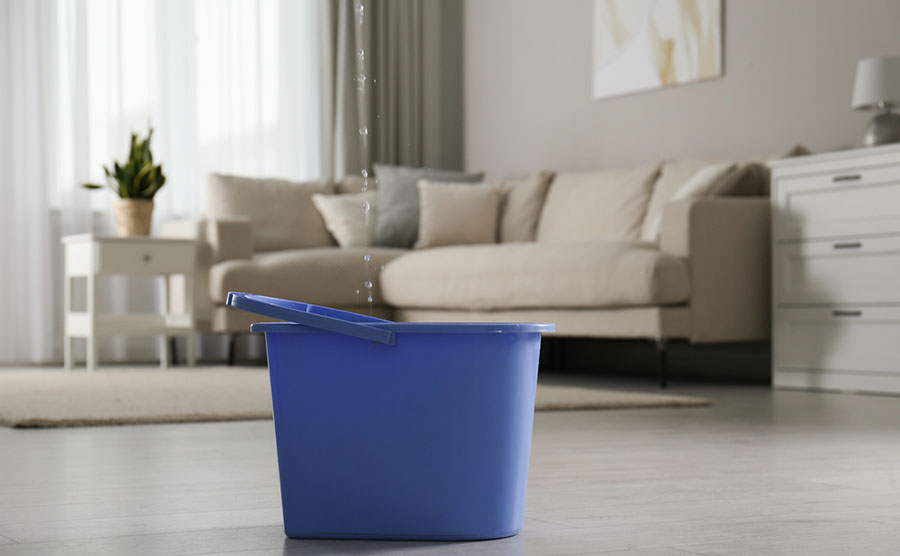
When it’s raining, most people would prefer to be watching a movie in bed than dealing with a roof leak. Unfortunately, developing a leak during the rain is a harsh reality for many homeowners. Knowing how to stop a roof leak while it’s raining is crucial – and we’re going to tell you exactly what to do!
When a roof leak develops while it’s raining, it’s crucial to act fast. First, find the source and collect dripping water with a container. Once you’ve done that, move all furniture out of the way. If possible, place a tarp over the leak on your roof to stop the water until you do a proper repair.
If it’s raining outside and leaking inside, you won’t be able to stop the rain, but you can contain the leak and minimize the damage it does. In this article, we’ll break down everything you need to know about stopping a roof leak in the rain, finding the cause of the leak, and more.
How to Stop a Roof Leak While It’s Still Raining
If your roof begins leaking while it’s raining, there are specific steps you can take to contain the leak and minimize the damage it does – at least until you can get someone to repair the issue causing the leak! These are the steps you should take for those trying to stop a roof leak in the rain!
Here is a quick rundown of the steps you can take to quickly but temporarily stop a leak in your roof while it’s still raining outside:
- Find the source of the leak
- Contain the leak
- Move all furnitire away from the leak
- Look for water pockets
- Try to stop the leak from the outside
- Dry up all water
- Call an emergency roof repair service if needed
Now that you know the basic process let’s take a much more in-depth look at each step.
1. Finding the Source of the Leak
Finding the source of a leak is an essential step to dealing with it during the rainstorm and can be crucial for after too. Furthermore, it’s crucial to distinguish the cause of the leak. If it’s presently raining, that’s a likely culprit for the leak. However, it could also be the result of an issue with your cooling or heating unit.
That’s why it’s important to analyze the leak’s location to determine if it is coming from the roof. If the leak occurs in an area that’s not near your cooling or heating unit and the connecting vents, it’s likely the result of an underlying issue in your roof. It’ll be hard to deal with this immediately.
The rain has essentially exposed a weak spot in your roof that you need to assess and repair. If you find one leak while it’s raining, you should ensure that no other leaks have developed that you are not aware of.
Later in this article, we’ll look at the common causes of roof leaks. However, if it’s currently leaking, there are some immediate steps you need to take before finding the exact cause of the leak and getting it properly repaired.
2. Contain the Leak
Once you’ve found any ongoing leaks during the rain, you’ll want to contain the leaking water. To any drips, it’s time to break out any buckets and pots to collect the water from the leak(s). Remember, a leak is not only caused by damage but can cause damage itself.
Using buckets and pots to contain leaks during the rain is a crucial step. This could protect your walls and flooring from water damage. When you’re already going to need to get an issue in your roof repaired once it stops raining, you don’t want to fork out unnecessary cash repairing damaged walls and floors.
The eventual clean-up will also be a lot easier when the leak has been contained for the most part. Remember to ensure that the containers being used to collect the leaking water do not overflow!
3. Clear the Area Where the Leak Is
Depending on where your leak is happening, you’ll want to clear the area as much as possible. This prevents your belongings from being damaged due to the ongoing leak. You’ll want to move any furniture items that the dripping water could damage.
Special care should be taken to carefully remove any electronic devices from the area of the leak. Water and electricity are a dangerous combination. Not only could the electronics be permanently damaged, but they could be a safety hazard when exposed to water.
4. Look for Water Pockets That May Have Formed
If a roof leak develops while heavily raining, water pockets are bound to form in your roof. This occurs when water pools inside your roof. If this is the case, you will notice a wet bulge that starts to form on the surface of your ceiling.
These water pockets that form due to roof leaks during heavy rain can damage the structure of your home, which could be very costly to fix. Therefore, it’s important to drain these water pockets that form during heavy rain.
To do that, you’ll need something to catch the water. If you can, get someone to help you by holding a bucket up, ready to catch the water. Using a screwdriver, make a small hole in the center of the water pocket so that the water can drain out of the pocket. Do this for any water pockets you spot forming.
5. Stopping the Leak from Outside

When a leak develops while it’s raining, it is possible to stop the leak from the outside using a tarp. It’s important to practice caution when attempting these methods, as the rain could be a safety hazard.
Using a tarp on your rooftop is perhaps the easiest way to stop the leak until you can find the cause of the leak and do a proper repair. To do this, you’ll want to cut a sheet of plastic (or any water-resistant material you have handy) that is big enough to cover the damaged area.
If you have a staple gun or short nails, you can use these to fix the tarp to your rooftop temporarily. Be sure not to puncture the roof by using nails that are too long, lest you cause another leak.
6. Dry the Area of the Leak
Once you’ve contained the leak, cleared the area, and dealt with any water pockets that may have formed, it’s time to ensure the area is dry! Standing water can not only damage your home, but it can encourage the growth of mold within your home, which can be even more troublesome to get rid of and fix.
Luckily, drying the area shouldn’t be too difficult, assuming you managed to contain the water leaking into your home in time. A few towels should do the trick! To facilitate this drying process, try to open windows or use your air conditioner to ventilate the area.
7. The Last Option for Severe Roof Leaks
If you’re struggling to deal with your roof leak during heavy rain, you always have the option of calling an emergency roof repair company. While this type of service can be pricey, it will get the leak dealt with and prevent any damage to your property or belongings that a severe roof leak could cause. You’ll be able to find an emergency roof repair specialist near you through a simple Google search.
Tips for Cleaning Up After a Roof Leak
Once it’s stopped raining and you’re waiting for someone to come to repair your roof, you’ll want to clean up inside. Here are some tips for cleaning up your home after a leak!
- Increase the Ventilation in Your Home – Once the rain has stopped, be sure to open as many windows and doors as possible to improve the ventilation inside – especially if you weren’t able to contain the leak immediately. You can use your AC to facilitate this.
- Clean Any Surfaces the Leak Affected – From your walls to your floors to your belongings, anything that the leaking water touched should be cleaned and disinfected. This will kill any bacteria from the water and ensure that mold does not form within your home.
- Re-check Water Pockets – Once it has stopped raining, any water pockets that were found during the leak should be checked again. This will allow you to drain the remaining water from the roof so that it can dry before it gets repaired.
- Schedule Regular Roof Maintenance – In addition to getting the direct cause of your leak fixed by a specialist, it’s important to get regular roof maintenance done. This will help ensure that you’re never caught off guard by a leak during the rain!
Common Causes of Roof Leaks
As we discussed earlier in this article, the first step in dealing with a roof leak is to locate the source of the leak. This will allow you to take the appropriate measures in dealing with the immediate leak. However, knowing where the leak is coming from is crucial in – eventually – getting the issue fixed.
It’s important to understand that the rain did not result in a leak. When your roof leaks while it is raining, there is clearly an underlying cause for your leak. Using our list of the most common causes for roof leaks, you’ll be one step closer to pinpointing the cause of your roof leak and getting it fixed.
1. A Hole in Your Roof is to Blame
This one might seem obvious, but it’s been the cause of many roof leaks! Holes can develop over time if you don’t adequately maintain your roof. Holes can even develop if something hits your roof, perhaps during a storm.
Holes are often even left behind when you remove fixed objects on your roof. Removing items and vents from your roof can leave behind holes and openings. Ultimately, regardless of how the hole formed or what caused it, it could be the culprit behind your roof leak.
2. The Gutters are to Blame
Gutters are beneficial when it comes to getting rid of excess water when it’s raining. However, if your gutters are not cleaned regularly, they could become clogged. This will result in your gutters having the opposite of their intended effect!
Clogged gutters can subsequently lead to the buildup of water on your roof. When water is left like this on your home’s rooftop, it can cause a leak to develop. Regularly cleaning your gutters will help prevent potential roof leaks in the future!
3. Missing or Damaged Shingles are to Blame
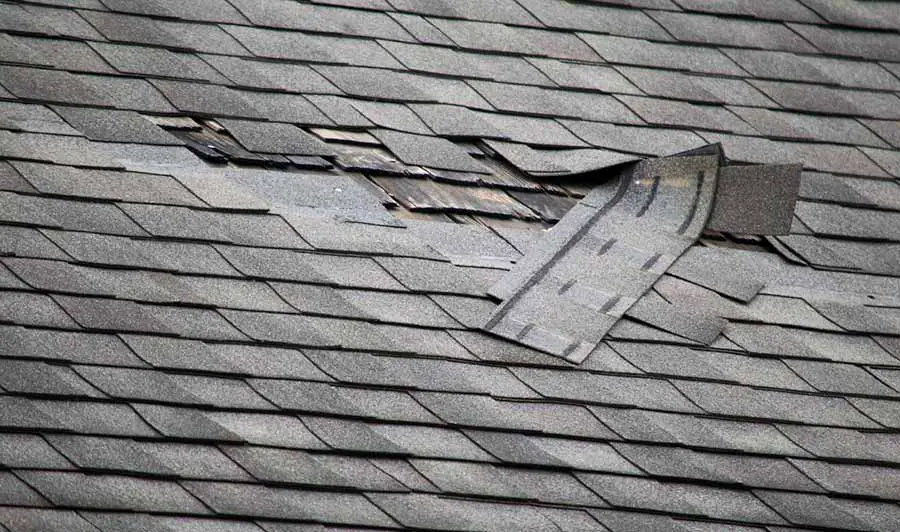
Above, we discussed the important role gutters play during bouts of rain. Your roof shingles play an equally important role, guiding water towards the gutters. If your roof shingles have been damaged – or not installed correctly in the first place – they could be the reason for your leak.
If you’ve recently had a spell of bad weather, it’s always a wise idea to inspect your rooftop when the weather has calmed down. This way, you’ll be able to locate any damaged shingles and repair them appropriately.
4. Old Age is to Blame
Roofs don’t last forever, unfortunately. Depending on the type of material used for the construction of your roof, your home’s roof will realistically last anywhere between twenty and fifty years.
Over time – and many different storms – your roof is bound to show signs of wear and tear. When these signs begin to present themselves, you’ll be more at risk for leaks. It’s a good idea to continuously monitor the state of your roof and the materials used to construct it.
5. Your Roof’s Architecture is to Blame
Above, we looked at the materials used to construct your roof; now, it’s time to look at the actual design of your roof. One important factor to consider in this regard is the slope of your roof. Roofs that are flat or have rather shallow slopes are more prone to developing leaks.
Another aspect to consider in terms of your roof’s architecture is whether or not you have a skylight or a chimney. When skylights or chimneys aren’t installed properly, they can be the cause of the leak.
6. Flashing Damage is to Blame
Flashing are thin metal pieces that are installed beneath your roof’s shingles. Flashing functions as a waterproof layer between your roof and the shingles. If your flashing is damaged, it could be the reason for your roof leak.
If your flashing becomes exposed due to a missing or damaged shingle, the flashing itself can become damaged. The damaged portion of your roof’s flashing will need to be replaced to repair the cause of your leak. If you notice leaks forming near a chimney or a skylight, you should investigate this possibility!
7. Your Dirty Roof is to Blame
If your roof has become littered with debris over time – likely due to bad weather – this can lead to a leak developing. Branches, sticks, and leaves can pile up on your rooftop over time. When not regularly cleared, this debris on your rooftop can impair water flow from your rooftop during the rain.
This means that the water will pile up on your roof and can cause a leak to develop. That is why homeowners must regularly get their rooftops cleaned. By cleaning the roof, homeowners will also be able to spot other weak spots that need to be repaired – weak spots that also could become leaks somewhere down the line if not dealt with.
Conclusion
This article looked at the different steps you can take when dealing with a roof leak during the rain. We broke down the whole process from securing the water flow from inside to putting a temporary tarp over the leak from the outside. Everything you need to know to deal with this unpleasant situation – and even how to prevent it from happening again!



